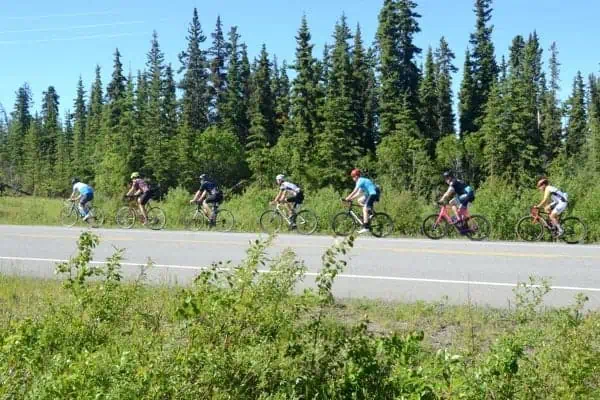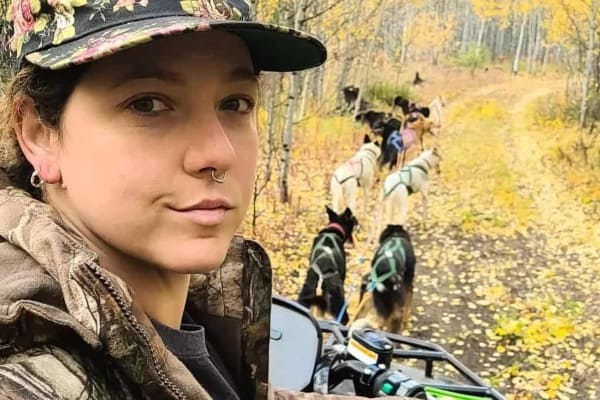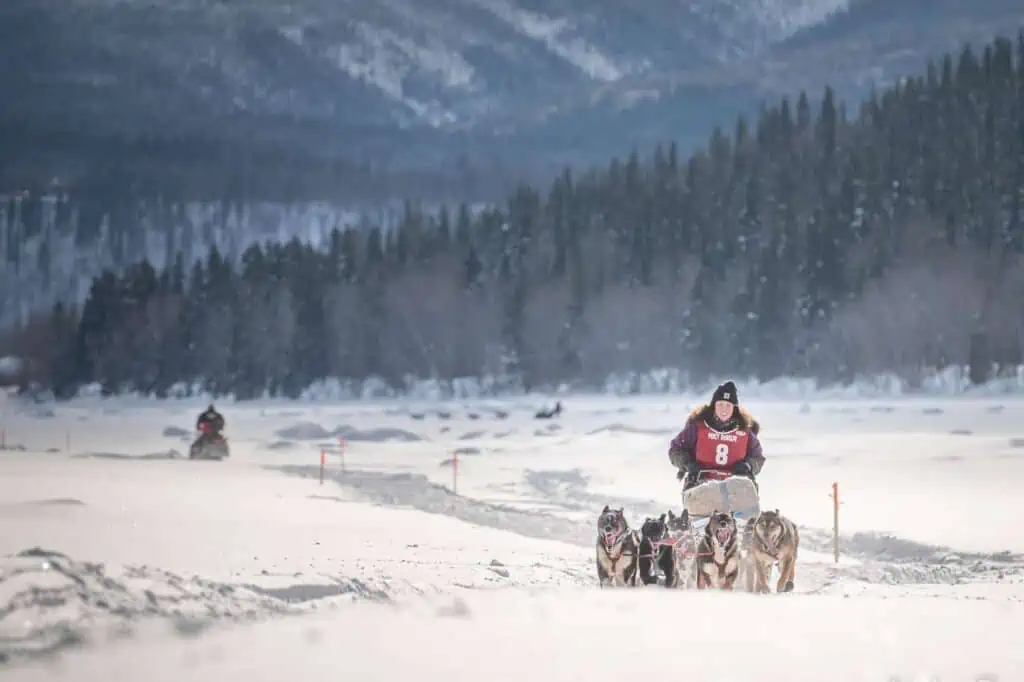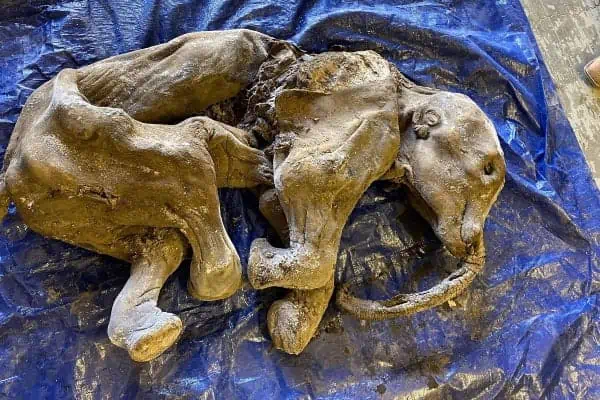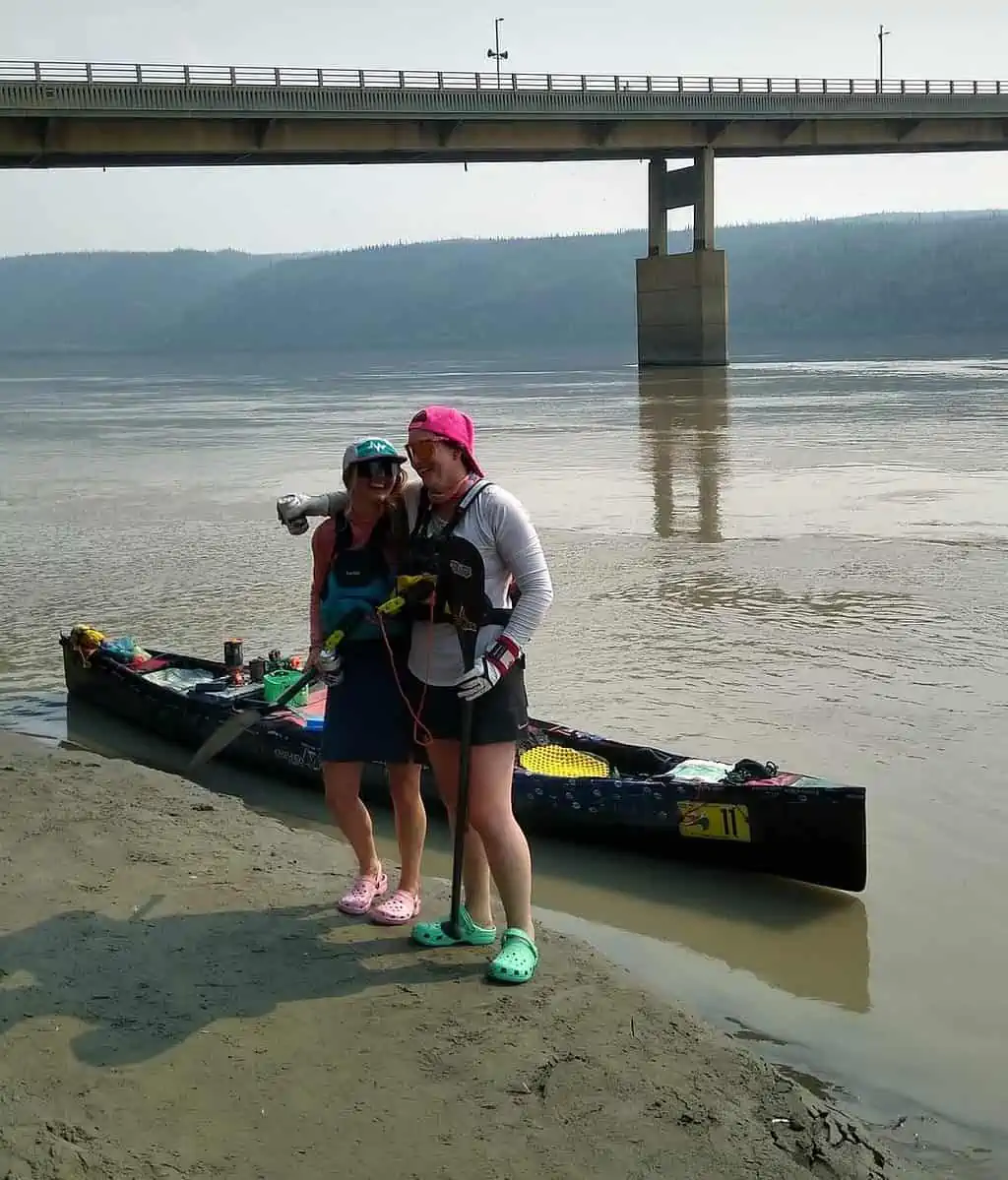
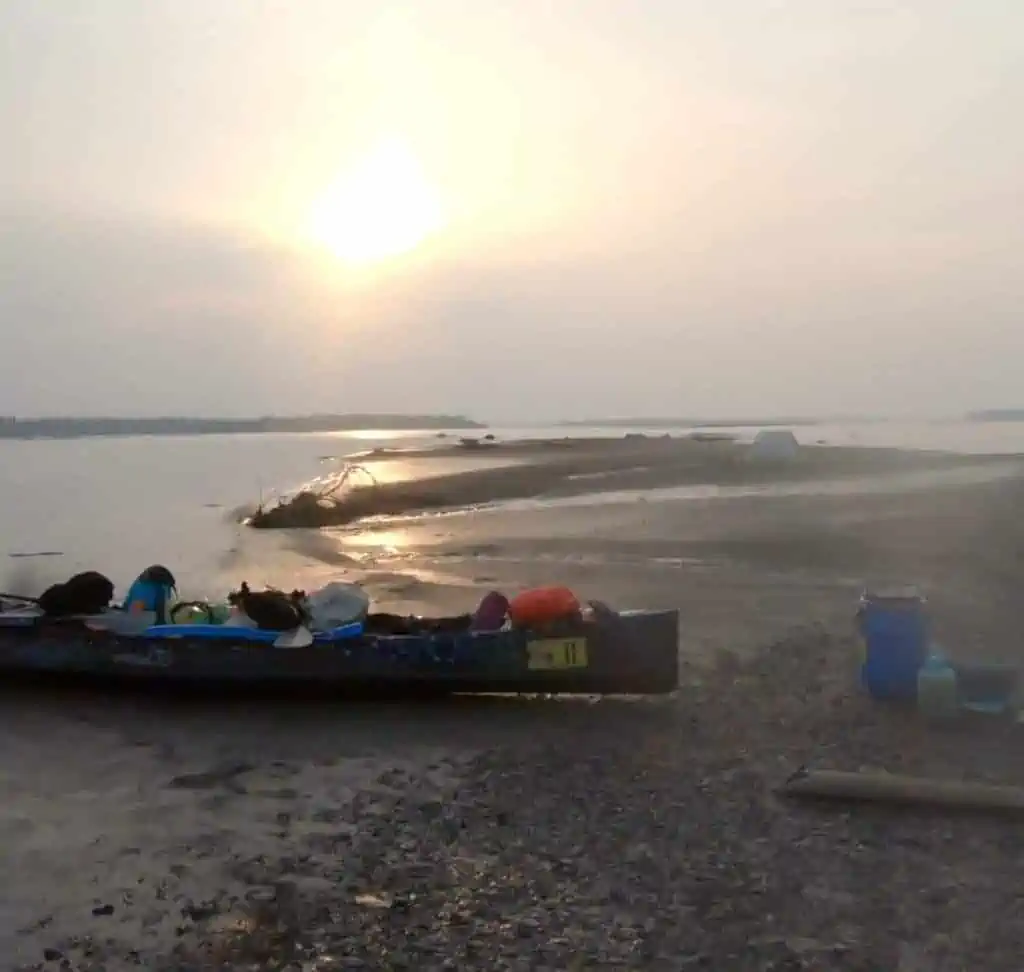
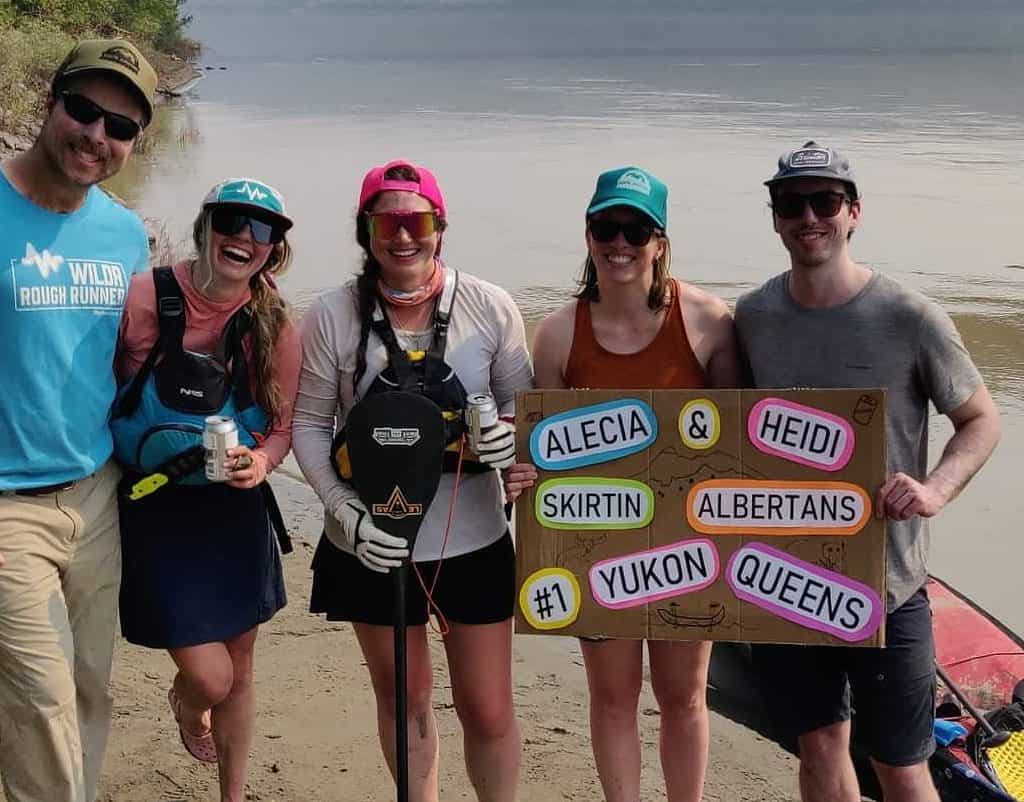
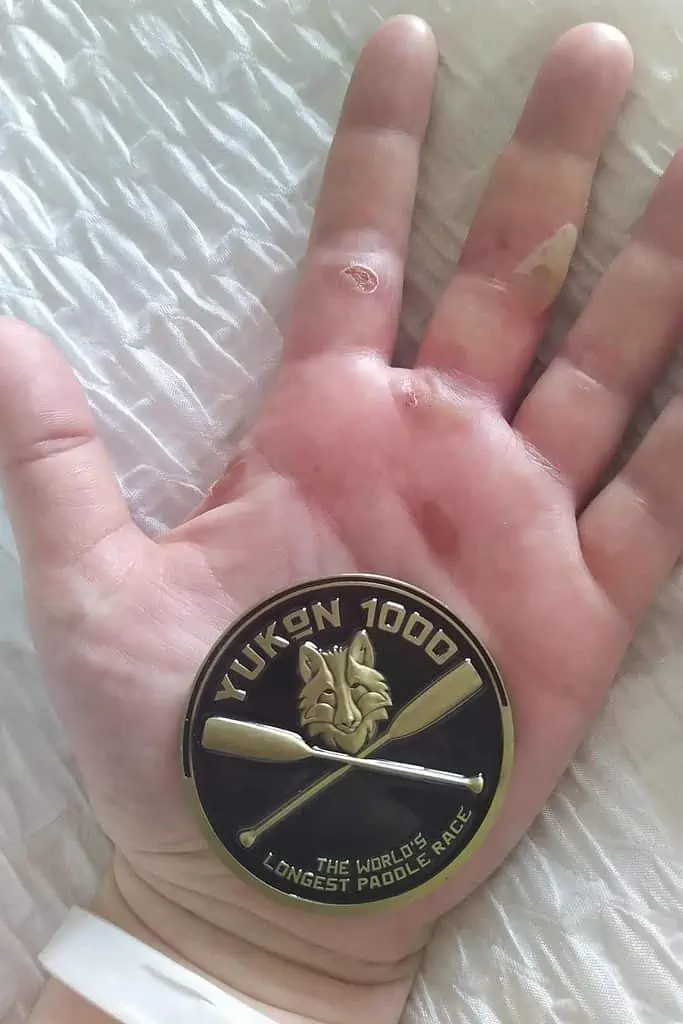
Recently I had the privilege of speaking with two women from Alberta, Heidi Virtanen and Alecia Williams, who recently completed and placed exceedingly well in the Yukon 1000, a 1000-mile international paddling race established in 2009, starting in Whitehorse, Yukon, and ending in Dalton Bridge, Alaska.
Known as the longest paddling race in the world, as well as the most-remote and self-reliant, the Yukon 1000 is an extreme undertaking that requires strength, endurance, bush smarts and thorough planning. There is a scrutinous application process for aspiring racers, and for good reason—paddlers are expected to have reliable survival skills and be able to self-rescue if needed. The race includes the paddling categories of canoeing, kayaking and stand-up paddleboarding.
The only all-women canoe team this year, Heidi and Alecia (a.k.a the Skirtin Albertans) set a positive example for women paddlers, and those aspiring to be, by placing 1st for women, 1st Canadian team, 2nd canoe to reach the finish line, and 4th overall in the swift time of six days, eight hours and 38 minutes. This gives them the third-fastest canoe time in the history of the race, including men, women and mixed teams.
I interviewed Heidi and Alecia two weeks after they got off the water, to get an idea of what it was like for them to prepare, endure and finish such an epic race. They enjoyed the opportunity to reflect on their experience and to share their respect and admiration for one another. As they spoke, I heard their genuine love of paddling and the Yukon River. I also observed their positive attitudes and how they embraced being women, which shaped their race experience into the success that it was.
Q: How did you hear about this race, and what moments in your life inspired you to take part?
Heidi
My dad is a paddler and was my original inspiration to start canoe racing. He belongs to the Canadian Senior Dragonboat Club, in Toronto. He paddles his outrigger canoe daily in the summer, and we had an assortment of boats at the cottage growing up. Almost everyone who grows up in Ontario has some exposure to paddling, even if just a little bit, but I was only ever a recreational paddler. My dad’s teammate loved the Yukon River Quest (YRQ), the 715-kilometre paddling race from Whitehorse to Dawson, and it stuck in my head for many years, as a challenge I wanted to attempt, so a connection was made to the Yukon.
Originally, I had thought I would paddle the YRQ with my dad one day, but then I found a friend crazy enough to do it with me! I completed the YRQ three times between 2017–2019. Through the community of paddlers I met during those races, I learned about the Yukon 1000.
I signed up for the Yukon 1000 for the whole package, not just the race. I fell in love with the community and river up here, and when the Yukon 1000 was in grasp, it seemed like the next step. Also, what’s beyond Dawson? I wanted to know!
A certain kind of person is attracted to this kind of race, not necessarily marathon paddlers with technical racing skills. I like these races because you don’t have to be the strongest or fastest to do well. There is much more to it: mental toughness, planning, pushing your body to such extremes, and sleep deprivation. I am better at those things than being fast or strong. The race fits my physical abilities better.
I had applied to the Yukon 1000 race and was accepted in 2019, but the world shut down because of Covid. So, I had been waiting to do this race for three years! By the time things opened up again, I needed to find a new paddle partner, and Alecia was the only friend who came to mind.
Alecia
Heidi would go up north, every summer, and do the wild YRQ race and come back with blisters and stories. I had heard her paddling partner talk about it. It sounded incredible. I come from a trail hiking and running background, so when I heard about the Yukon 1000, it terrified me because I wasn’t a paddler, really, but it also sounded exciting.
Heidi asked me without thinking I would say yes . . . but I did.
I had done a lot of solo stuff before and the idea of working with Heidi on a team was very exciting. One needs to be strong, at all times, and rely on your partner and push yourself for them. Being in a two-person vessel made me want to try it. You can’t be any more of a team than two people in a canoe, from start to finish. They talk about how remote this race is and how you need to be ready for any kind of situation and be reliant on each other as part of a team.
Heidi was confident that if we worked hard and trained hard, we could do it. I believed her, but was still terrified. There was a ton of logistics and learning how to paddle for a marathon canoe race. As soon as I made the decision, though, people in the canoe world excitedly shared their knowledge and took me under their wing.
Q: How did you feel leading up to the race?
Heidi
Partnering up with Alecia really changed things. Alecia hadn’t done any marathon paddling before, but she had super skills in other areas that were related. She has a kinesiology and fitness background, and her business is all about preparing bodies for outdoor adventures. Alecia made us a training program, with a lot of science behind it, and she also has a lot of knowledge of sports nutrition and made a plan for what we should be eating and when, so we got the most prepared we could have with all that background.
Two-and-a-half months before the race, I got Covid, and its effects lasted up until two weeks before the race, which affected our training.
Alecia was chill right before the race, but I was panicking. I felt like the liability on the team because of being sick for so long. It had created a lot of extra stress and affected my ability to train and the amount of time I could spend in the boat beforehand. I get stressed with everything before these races, so it was difficult for me.
Then we heard it was a high-water year. This is usually good news! The higher the water means the faster the race—but also the harder it is to paddle in some sections of the river, and the more challenging it is to find campsites.
The YRQ runs a week and a half before we start our race. I have friends from that race and ran into some of them in Whitehorse after they were finished. Some were trying to talk me out of the 1000. These were people with my best interests at heart, who just ran the river. The biggest issue was that, with the record-high water levels, the shore would be inaccessible in a lot of parts. In the Yukon 1000, you have to pull over by a certain time in the day and camp, but they warned there is nowhere to camp.
Another big concern was that in the YRQ, this year, the river was much more turbulent than usual and many boats capsized. Five Finger Rapids, which is normally not a huge challenge and had been pretty easy when I had run them before, were Class IV Rapids during the YRQ, we were told. Lots of experienced paddlers were dumping in them (one out of seven teams). It really seemed like it was up to the river whether the boat made it through or not, not the skill set or experience of the paddlers.
YRQ has safety boats throughout, but the Yukon 1000 is a lot more wilderness: you’re on your own without safety boats. That means more of an issue if you dump, and there is no easy place to get out. It could be a long swim in quite-cold water to be able to find shore to self-rescue. I had a chat with my paddling mentor and said, “I don’t care if the race is harder this year … I just don’t want to make a dumb decision and put our lives at risk.”
Ultimately, Jon, the Yukon 1000 race director, decided to put a safety boat in at the Five Finger Rapids, this year, because of extremely difficult conditions. Once I heard that, I felt much better. The safety boat ended up helping two boats in our race, as well as some tourists who flipped in the rapids and were not wearing life jackets.
By the night before the race, I had already gone through such an emotional roller coaster that I had processed everything. So, I was chill the night before and morning of the race. We had spent days and hours organizing for this race and I was ready to start paddling and take the thinking out of it. Alecia seemed more ready for it, and she was calm the whole time. That’s what I like about her personality.
Alecia
I hadn’t paddled the river before, so I didn’t have the frame of reference to know what a high-water year meant.
I fluctuated between fear and hearing more-positive things. I was a bit concerned about north of Dawson. There are good race maps from Whitehorse to Dawson, with different route options, but beyond Dawson there was more problem-solving and figuring it out on our own. Past Circle, Alaska, no river maps exist.
As soon as I saw Heidi settle down, I felt we could do this.
I have never put so much prep work into an event. Every little thing: the daily tasks and designing ways to not get out of the boat, trimming the boat and getting everything on and in. The morning of the race, we just did the things we had practised, and I was so excited to get going and paddling. It was kind of a relief to get on the water and start paddling.
Q: Why race?
Heidi
Why race? is a good question! I wonder why people sign up for this race because it is not necessarily attracting top marathon racers; it’s a unique group of people—outdoorsy folk. I say I’m not competitive, but that’s probably not true. What matters most to me is proving to myself what I can do.
I went into the YRQ with realistic expectations. At first, my goal was to finish, then it was to do it a bit faster, then to be competitive in the women’s field.
In a similar way, I wasn’t going into the Yukon 1000 thinking of it like a race. I was thinking of it more like an undertaking, something I wanted to complete and hopefully not be last. Alecia said the same … except that she was also okay with being last.
We ended up doing really well, but neither of us knew. When we found out how we were doing, we thought, Okay let’s not mess this up and hold onto this spot!
I like the race environment because of the comradery with the fellow racers. We met different pods of paddlers, at different parts of the race, and it always felt collaborative and supportive.
Also, when you end up with such a happy, upbeat and easygoing partner as Alecia, it can be a great team experience. Before the race, we set out our rules. We had decided that we were going to focus on doing well for ourselves rather than competing with others. And, in the end, we really showed what we were capable of in a tough environment and paddling 18 hours a day. We lucked out on the weather, had the help of the strong current from high water and, funnily enough, it never really felt hard.
Alecia
I enjoy outdoor racing events of all different flavours. In the Yukon 1000, I found that people were genuinely excited to see and support each other to succeed. When we’d see another boat doing well, we’d be stoked for them and chat with them about camp spots or their experiences on certain sections.
Without the race environment, the undertaking wouldn’t have been as rich. The race gives a group of people the same goal, which elevates the experience.
We had our process and were focused on trying to do the best at our process each time, like our paddling or steering around a corner. These kinds of attributes come out of you while in a competitive environment: how to make dinner better, how to read the maps better, how to communicate better. And, I think we did get better as the race went on. Being in a race environment makes it okay to be obsessed about getting better.
Q: How did you prepare?
Heidi
One of the most-daunting parts of the prep was creating a map of the river from Circle, Alaska, to the finish line. Every team had to make their own maps for this section because they’re not available to buy or find anywhere. Making our own maps and a GPS tracker was one of the biggest challenges, because we didn’t know whether we were doing a good job or not.
We were also highly organized about our nutrition and meal prep. Alecia made spreadsheets about what we were going to eat for the day, accounting for energy and protein content. And I spent a lot of late nights pre-portioning meals and snacks and measuring drink powders for our liquid calories. It helps to take as much thinking out of things for the race. You get really bad at thinking when you’re only sleeping three to four hours a night!
We planned out our days and built systems to help with efficiency in our boat. Alecia made a cooking platform for her seat in the stern. She made coffee and cooked dehydrated meals on the boat with our Jetboil. We also had a plastic basket, with rope tied to each side, so that we could pass things back and forth safely. We tied everything down and pretty much used everything we brought.
Alecia dialed in with a first-aid kit, and her experience and mindset were awesome in terms of assessing hazards and risks and coming up with plans before anything happened. I had bad blisters and she would drain them every night and tape them every day. Another team had to deal with a pretty nasty infection because they didn’t address the injury and instead kept going.
Some things go out the window because you are tired. The sleep deprivation catches up on the last few days, so all of our redundant, hypervigilant systems helped big time when we couldn’t think straight out there.
Otherwise, the YRQ experience was helpful and I had lots of support on the paddling side. My YRQ race partner’s parents, Steve and Karla Ramsay, pretty much adopted me from the first YRQ I did. Steve is a phenomenal marathon paddler and amazing coach. He knows how to motivate and how to get the best out of people in specific moments.
We also were fortunate enough to be invited to a paddling camp hosted by an incredibly accomplished marathon paddler and wonderful teacher on the Saskatchewan River. Paddlers from all over get together to learn from each other. It was beneficial for Alecia to attend and to learn from people more experienced than me.
The paddling community is stoked to have new young people to teach, and they taught Alecia how to read the river and find the fastest current. These are essential skills if you are new to paddling and haven’t done races like this before. I’d say this community was fundamental to our success. We were the only two who got us to the end of the race—with a lot of people in our minds—but there were a lot of people who helped get us to the start line.
Alecia
We tried to anticipate what pains we might have or what could be safety issues, but there will always be things that we can’t mitigate or avoid. We had to ask, Is this something we can overcome with a system or through preparation, or is this something we are going to have to grin and bear? For example, with sleep deprivation we had one alarm, then a kitchen timer that would count down and go off afterwards as a backup system.
The paddling camp on the Saskatchewan River was super helpful. I learned how to keep a boat straight by calling “Hups!” for us to switch sides. I got to paddle with different paddlers and they watched me while I was in the stern, to check my stroke. We had to paddle upriver on the way out of the camp, which is trial by fire in the current. If I didn’t pick the right place in the river, it was harder on both of us. It was a super-supportive and sharing environment and I felt like a completely different paddler by the end of it.
I enjoyed making our fitness-preparation program. For really long-distance events like the Yukon 1000, you will never do the race before the race. So, it became more about what components of our bodies do we need ready for the start line. We wanted to be going into the race with solid shoulders, forearms and enough muscle mass. On day 5, when we’re in a caloric deficit, we wanted to still have enough muscle and structural integrity to deal with potential injury. Then we worked on energy systems because the easier it is going to feel, the less calories we’d need on the race. With fit cardio, even when it is hot out, our bodies can deal with the heat better and we won’t get to the point where we can’t handle it.
It was fun to prepare us. My husband even converted my rowing machine at home into a paddle-ergometer, so I could practise my paddle stroke and technique, with more resistance, so that I didn’t hold us back on the river.
Q: Do you feel this race was about challenging nature, the elements and/or technology?
Heidi
Well, it would also be nice to take a motorboat 1000 miles on the river—nothing wrong with that. Haha, no, but seriously, I find the challenge is part of the fun and you prepare for that in advance.
Alecia had a spreadsheet of all the terrible things that could possibly happen to us and what we would do about them. We packed the right clothing and gear. You can’t change the weather, and the goal doesn’t change. If it’s raining, put your rain gear on and keep paddling down the river.
It’s important to stay humbled by the environment you are in and to be really respectful of it. I hadn’t been scared by the river since my first YRQ race. This year, though, it was a new and scary race to me, and particularly scary conditions. That is partly why we did so much preparation. And during the race we really didn’t have a lot of adversity; it was the luck of the conditions that week, but we were ready for things if they were to happen.
You know, it’s interesting, we saw more people out there than I thought we would!
Alecia
Yeah! Haha! One day we saw a cleanly groomed man in a boat in the middle of the river, and he stopped by to ask us whether we’d seen his friend! . . . Or maybe it was a hallucination from all the sleep deprivation? Hahaha!
We never thought of the race as overcoming the river. The power of that river is more than both of us, any day of the week, and humbly accepting that is a critical part of being successful. If you’re going to think you can overpower something in the wild, you’ll be in a bad situation.
If anything, I learned about going with the flow, looking at what was going on, being grateful to be on the river and for every kilometre we experienced. The river is just the river. It is neither kind nor cruel. I hear the idea sometimes from the outdoors community that you are somehow hardcore if you go and do these things outside, but this can be negative. In actuality, experiencing nature at its best is realizing how small you are.
Q: Do you feel your successful placement means something for other women paddlers?
Heidi
I don’t know why fewer women do things like this. We are the second female canoe team to finish the race, and I think only three have started. I think our placement surprised people and seemed like a bigger deal because it’s so much rarer. We are just as capable and have no real limitations; well, maybe it’s harder for us to pee in a canoe.
I never felt like this is going to be harder for me because I am a woman, especially this race in particular. It is a team event and more about picking the right person to do the race with and having trust and confidence in their abilities—as an individual and as a woman.
Alecia was who I wanted to do the race with; I wouldn’t have chosen anyone else, regardless. We made a good team and that is what it comes down to. Communication is key, which females are traditionally better at doing, as well as nurturing. Alecia was dealing with my blistered hands, every night, and checking in on each other came naturally—and even being able to say one of us is having a hard moment.
Alecia
We named ourselves the Skirtin Albertans for a reason. We like pushing ourselves, and we are women and don’t shy away from that fact.
Racers were surprised we did so well, and there is pride in that. Just because we are women doesn’t mean we’re going to be back in the pack. Feminine attributes actually helped us do better, like caring for our partner and focusing on process more than outcomes.
I did have one extra female challenge at the beginning. I had my period during the first two days of the race. A lot of my support people knew about it, which was kind of funny because it could have impacted our race. I still had it the first two days of the race, so making sure I was dealing with the pain and staying clean was an extra challenge. Again, we spread-sheeted it out and talked about it a lot. I guess this is an extra challenge you wouldn’t have if you were a guy.
We peed into plastic milk pitchers, which Heidi discovered from her YRQ experiences hold just the right volume. A benefit of being in a canoe, rather than a kayak, is that the seat is raised. We wear skirts, not only because they look cool but also because they make it easier to pee in the canoe. We also had some custom-made cloths from Kula, which are silver-infused cloth, with antimicrobial, which we would reuse throughout the day instead of toilet paper.
Q: Were there any challenges?
Heidi
The race was not easy, but also not hard because maybe I thought it would be harder?
There’s lots of hype about paddling for so many hours and it being the world’s longest race. That said, it was the easiest trip to Dawson that I’ve had, partly because of the four hours of sleep every night, versus that continuous stretch from Whitehorse to Carmacks in the YRQ. In the Yukon 1000, you get to camp and sleep every night.
But, finding campsites was hard, especially because of the high water. We had a time window to find camp each night, but because of the river conditions it would take us longer to find camp. The first night it took over an hour to find a spot. We were borrowing a new carbon fiber Kissey canoe and didn’t want to bang it up, so we had to be careful along the shoreline in the fast current. We finally found a spot and I got out into the water, amongst the flooded trees, and stood there bringing the canoe back and forth to get the stern in so Alecia could get out. It wasn’t a glam camp, by any means, but that night three other boats joined us so it must not have been that bad! For our second camp, we got lucky and camped at Fort Selkirk, and it got easier to find camps every day after that. But once, the sleep deprivation gave me auditory hallucinations. It sounded like a whole band of music was playing next to our camp one night. They kept me up!
We did experience a big storm, right before Dawson, which I have dealt with before in past racing experiences, so it didn’t seem too bad for me.
Alecia
We expected the race to be hard, so when it was hard, we would say “Yes, this is what we are ready for.” We worked through this lens.
In the situation of the thunder and rain storm, before Dawson, it was hard to find a place to pull over because of high water. Water was collecting in our canoe and the storm was moving with us. If we pulled over and stopped moving, we were at higher risk of hypothermia. We eventually got through the storm and got to put dry stuff on, and the next morning we fully drained the boat. It was a challenging moment—being in the storm and trying to balance the decision about whether to pull over and risk hypothermia, or to stay in the swamping boat. We determined that the boat sinking was not super likely, and talked about the possible outcomes. I’m glad we made the right call.
I was totally overwhelmed by how big the river was towards the end. After navigating the really wide section, Heidi said, “I felt we earned it that day and it was really fun trying to find the best route.” Her viewing that very-difficult thing as a game was testament to her experience reading maps and previous races. It was really fun to witness that. I was overwhelmed and fried by the end of that day. It was the most-demanding navigation day as well.
Heidi has a high threshold for suffering. I remember her saying once that for the first two hours, her hands hurt, “But then the blisters form the shape of the paddle and it’s fine!”
I had a romanticized idea of travelling the river by canoe and wondered if that was going to change after the race. But it didn’t. I still hold these romantic thoughts about paddling.
Heidi
That part of the river Alecia just talked about is called “The Flats,” and it gets up to five kilometres wide. We thankfully didn’t have headwinds, which are typical in this section of the race. We did have some technology issues, which meant we didn’t have a GPS tracker to follow, but we didn’t make any terrible decisions in there, I don’t think. Everything else we used to navigate that river was handed to us from someone else, except for that section. I felt like we really earned it those two days. We figured out how to get us through that section on our own. The only option was to keep going down that river; there was no point in dwelling on any of the tech hiccups.
The Five Finger Rapids, we were amped up for. That was the thing I was most worried about. They were big this year and Alecia picked a good line, so we avoided much of the wave train.
Alecia
Heidi paddled so hard through the rapids—like a motorboat! Her entire arms and upper body hurt afterwards.
Q: Any easy moments?
Heidi
We were lucky with Lake Laberge this year—it was flat for most of our trip across. It was a really hot year, and hot days are not my forte. But I was happy with how we managed the heat.
The race wasn’t as hard as I thought it might be, because Alecia was so strong and upbeat (she’s a bit of a freak that way). I thought I was finally going to see her crack in this race, and it never happened. I get quiet when I’m tired and I had to explain that to Alecia. She was just the easiest personality to deal with, which eliminated what could have been really hard moments. She was present, attentive and enthusiastic. I’ve never seen her unpleasant … seems like a simple thing, but pretty unique for an undertaking of this magnitude.
Alecia
And Heidi has a high threshold for what’s considered hard to her. She might endure a hardship, but always follows it up with, “But it wasn’t that bad.” It’s fun to be in a boat with someone who can lean into that.
Heidi
Neither of us had to stop or slow down because of our mental state. It wouldn’t have been an issue if we did, but neither of us had a hard moment where we needed help. If we had, both of us would have been there for one another.
Alecia
Heidi was able to wash her hair on the boat, the last day of the race. Even hair brushing was more vital than I thought. If we didn’t brush our hair, it would be one giant dreadlock by the end of the race!
Q: And how about that amazing finish?
Heidi
It was cool to go in without real expectations of ourselves and to learn about how well we had done from other racers … people complimenting some of the systems we had, things we had thought of. The advantage of doing everything in the boat is that the current was so fast, so we could just float and still get somewhere while doing other things. Not getting out of the boat meant not getting out of the current.
It was hard to know what position you were at in the race. When we got to Eagle, we had to stop and call our passports in to customs from a landline phone on the side of the laundromat. I went to make the call and when I came back a men’s canoe team was there. They are two strong well-known competitive marathon paddlers. I laughed and said, “If you’re behind us, you must be doing terribly!”
But they responded with, “Oh no, you girls are doing really well. Slow and steady wins the race … I mean, regular and steady.” We thought we were in the middle to back of the pack, at this point, but they let us know we were in third or fourth. They would fall behind and then pass us again, later every day, and we would look forward to seeing them. It was nice to see people who are a big deal in the sport, each day, and for them to recognize we were doing well at what this race required. It was a bit of a motivator to know how well we were doing and to stay strong and keep doing what we were doing.
Then, seeing Jon, the race director, at the finish line, and hearing feedback from him, saying it looked like we got stronger throughout the race and improved our navigation skills. I never thought we would do well in the race … it was never our goal, but I’m very proud of us. We did really well and Alecia was a strong partner and we made a good team. We surprised a lot of people and we surprised ourselves. Our team bio was a picture of us in pink tutus and big flashy sunglasses—and maybe people didn’t take us seriously … well, maybe I didn’t take myself seriously.
It was really cool to hear how many friends and family were tracking our progress back at home (way more than I thought) and that we made our paddling community proud, including whose boat we were borrowing. It was the best feeling.
Alecia
Finishing the race itself was surreal. Part of me didn’t want it to be over. Getting to the finish line and having friends at the finish line who had made such a huge effort to be there, and feeling the swell of support behind us … that was amazing. The placement is not necessarily what I am proud of. I am prouder about how we figured out how we could do what we did in the best possible way, and stuck with it.
When Heidi first asked me to be her partner, I knew she could finish it but I didn’t know whether I could finish the race. When we finished it together, it blew me away. I am still processing it. It will be a journey to process this as well.
Q: What would you say to people thinking about entering a race like this one, or simply getting outside?
Heidi
What gave us a big leg up was the support and community we had, and it exists in a lot of realms, in terms of getting outdoors. Most people are supportive and willing to share what they know, and being outdoors is a really good mental break from technology and all of that. It’s cool when your only focus is what is in front of you. Life was simple on the river, and I think you can get that peace in a lot of outdoor activities and adventures.
I try and tell everyone to do these races. When you say you are doing a 1000-mile race, people either don’t know what that means or they think it’s insane, and maybe it’s somewhere in the middle. If you are stubborn enough and you can get across Lake Laberge at the beginning, you can finish the YRQ and the Yukon 1000. It’s really about your mind, and being determined and being organized. The river does a lot of the work for you.
Alecia
When you’re doing anything in a more-remote environment, take yourself lightly and have respect for the situations and be humble when you are out there, and get help from others. Being able to accept help from others makes these kinds of events possible. Take yourself lightly, take the challenge seriously, and put the work in beforehand.
Q: Are you planning another race in the future? Or are you taking a break?
Heidi
I was joking that I can retire now because this is the world’s longest race, but Jon, the race director, mentioned he is planning a 2000-mile race. I think the only interesting athletic pursuit I have is paddling, whereas Alecia is a jack-of-all-trades for outdoor wilderness. But I’m already trying to talk her into the 2000.
Alecia
I somehow miss paddling already … good thing I bought a canoe when I decided to do this race. To get my fix, I convinced my husband to paddle to the other end of Cameron Lake tomorrow night for dinner. You’re welcome to come if you’d like, Heidi?!

